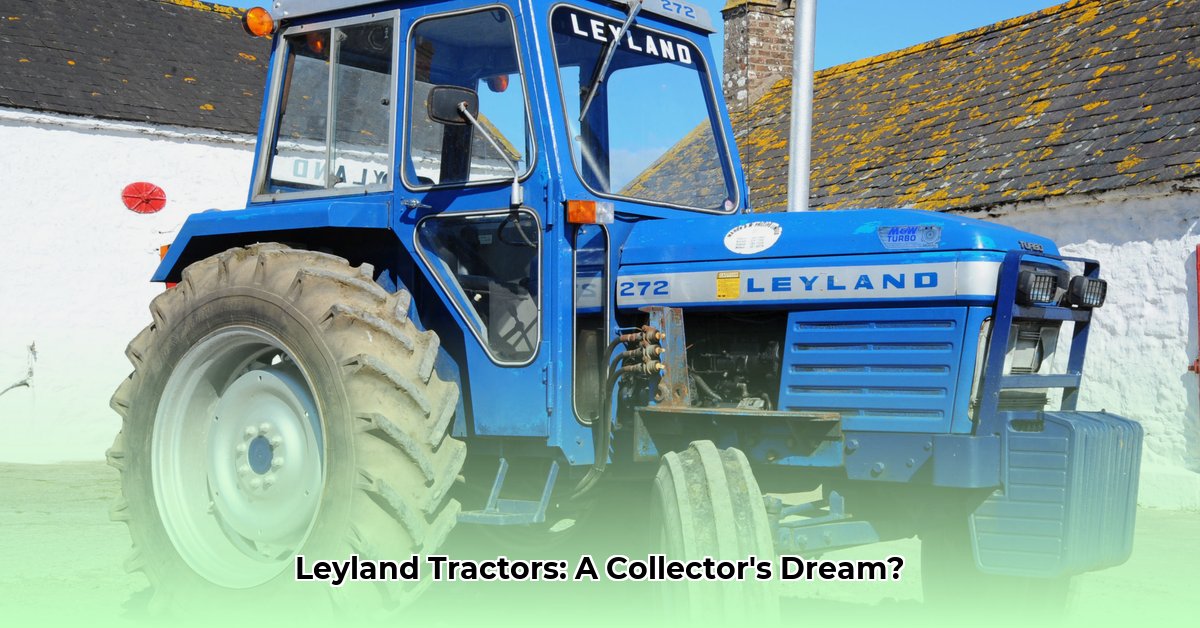
The deep rumble of a vintage Leyland tractor, a sound echoing across sun-drenched fields, whispers of a bygone era. More than just rusty relics, these British workhorses represent a significant chapter in agricultural history and a surprisingly vibrant collector's market. For more on British tractor history, check out this related site. This article delves into the Leyland story, from its origins to its current value, offering insights for collectors, enthusiasts, and anyone captivated by the legacy of British engineering.
A Legacy Forged in British Fields: From Nuffield to Leyland
Leyland's journey began not with the Leyland name, but with the Nuffield Organisation. These robust machines earned a reputation for reliability, becoming a familiar sight in British fields. Their simple yet powerful designs laid the groundwork for the Leyland tractor brand. The subsequent merger with BMC (British Motor Corporation) and Leyland Motors infused the brand with resources and expertise, leading to significant advancements. The introduction of the 98 series engine and the 9x3 Synchro gearbox marked a turning point, propelling Leyland tractors to the forefront of agricultural technology. But what truly cemented their iconic status was the adoption of the "Harvest Gold" paint scheme—a powerful marketing move that created a distinct and memorable brand identity. This strategic branding, combined with a diversified product line encompassing models like the 154, 245, and 253, solidified Leyland's position in the market.
The Modern Collector's Market: A Surprisingly Strong Demand
Today, the market for used Leyland tractors is a niche but active one, driven by the inherent rarity of these machines. Online listings reveal a price range from a few thousand to well over eight thousand dollars, heavily influenced by condition, rarity, and available parts. The availability of parts, in fact, significantly impacts a tractor's value and desirability. A well-maintained Leyland tractor represents a rewarding investment, but potential buyers must carefully consider the challenges of sourcing parts. This is an area where online forums and dedicated suppliers become invaluable resources. However, the effort invested in restoring a Leyland tractor is richly rewarded by owning a piece of history.
Technological Prowess and Practical Considerations
Leyland tractors showcased considerable technological advancements for their time. The 98 series engine and associated gearbox represented substantial progress in agricultural machinery. However, compared to contemporaries like Ford or John Deere, certain limitations existed. Direct comparisons are difficult due to variations in models and limited historical data; nonetheless, acknowledging these limitations provides valuable context to both the engineering challenges and achievements of the era. The ingenuity displayed in overcoming those challenges remains a testament to British engineering prowess.
Isn't it fascinating that these machines, despite their age, continue to draw such interest? What other factors contribute to their enduring appeal beyond their historical significance?
Investing in the Leyland Legacy: Opportunities for All Stakeholders
The Leyland tractor presents various opportunities for different stakeholders:
For Collectors and Enthusiasts: Preservation of rare models, building online communities for knowledge sharing, and development of restoration guides are key areas.
For Parts Suppliers: Strategic inventory management, development of reproduction parts, and the creation of user-friendly online marketplaces represent significant opportunities.
For Museums and Restoration Businesses: Acquisition of significant models for display, development of engaging exhibits highlighting engineering and cultural significance, and collaborations with collectors and parts suppliers are vital.
How can these stakeholders collaborate more effectively to ensure the ongoing preservation and appreciation of Leyland tractors? Consider the potential synergy between these groups to create an even more vibrant ecosystem for the preservation of this legacy.
Navigating the Market: Potential Risks and Mitigation Strategies
While the Leyland market offers significant potential, certain risks must be addressed:
| Risk Factor | Likelihood | Impact | Mitigation Strategy |
|---|---|---|---|
| Parts Availability | Medium | High | Develop reproduction parts; build strong parts exchange networks. |
| Restoration Costs | High | High | Partner with skilled mechanics; develop effective sourcing strategies. |
| Maintaining Market Value | Low | Medium | Cultivate a strong community; create and share detailed resources. |
| Authenticity and Provenance | Low | Medium | Develop a standardized system for identifying genuine parts and authentic models. |
How to Restore a Classic Leyland Tractor Engine
Restoring a Leyland tractor engine requires considerable time, skill, and resources. The process involves a meticulous assessment of the engine's condition, sourcing parts (often a significant hurdle), thorough disassembly and cleaning, repair or replacement of components, reassembly, and testing. Joining a Leyland enthusiast club can provide invaluable support and expertise throughout this process. This detailed restoration process requires technical expertise, patient dedication and a thorough understanding of the machine's intricacies.
The Leyland Legacy: A Collector's Dream
Leyland tractors, an enduring symbol of British agricultural innovation, continue to captivate collectors and enthusiasts. Their distinctive design and historical significance contribute to their enduring appeal within a specialized collector's market. Their story serves as a testament to British ingenuity and the enduring power of a well-crafted machine. Their legacy thrives on the efforts of passionate individuals determined to preserve and share this noteworthy piece of history.